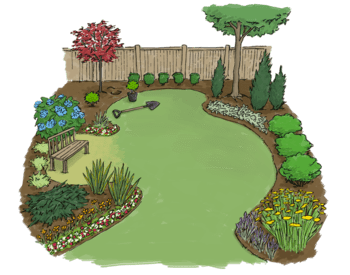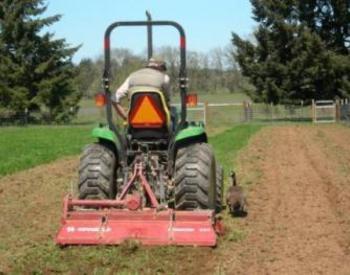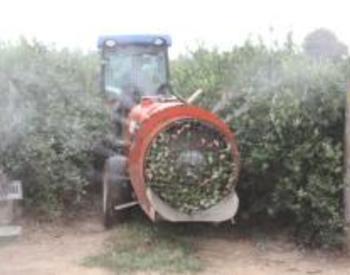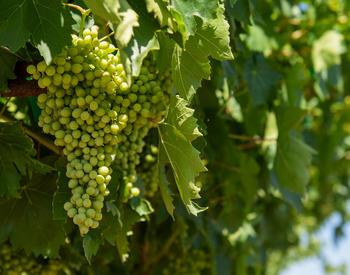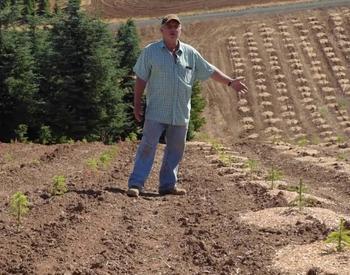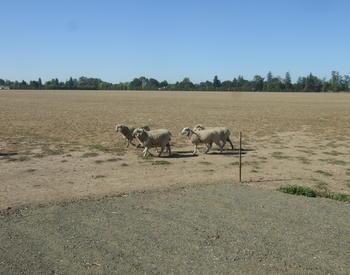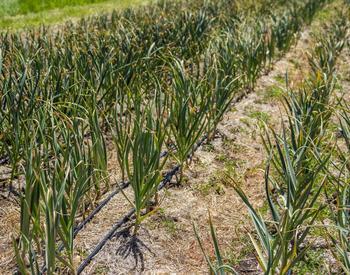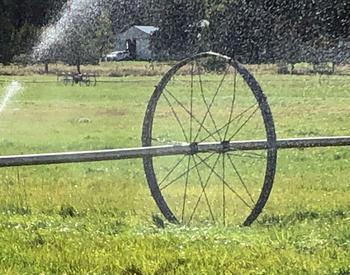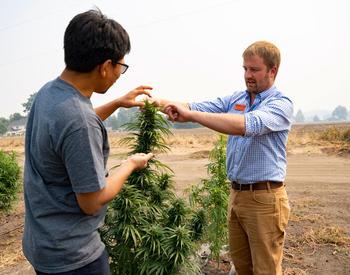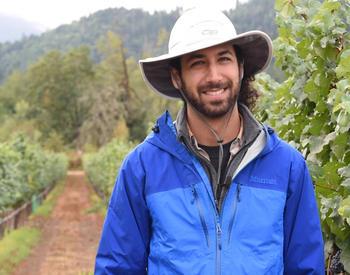What is mobile drip irrigation?
Mobile drip irrigation (MDI) combines the high efficiency of surface drip irrigation with the flexibility, lower hardware costs and convenience of center pivot irrigation. In this system, the drip tubing is attached to center pivot irrigation systems to apply water directly to the soil surface as the driplines are dragged across the field and to create a uniform wetting pattern across the entire irrigated area (Figure 1).
MDI consists of heavy wall, in-line drip hoses in place of nozzles or sprinkler heads that are spaced 20 to 40 inches apart. The sprinklers can also be left in place in addition to the dripline in a dual-purpose setup that allows switching between sprinklers and drip. This spacing is chosen based on the crop, the soil type and the rooting depth of the crop. The length of the dripline that drags behind the center pivot depends on the flow rate needed and the area that is irrigated during the movement. The length of the dripline increases with distance from the center pivot to apply more water similar to a center-pivot nozzle package.
Netafim and Dragon-line are two companies that provide commercial MDI components and/or design services. Netafim refers to its product as precision mobile drip irrigation (PMDI) while Dragon-line is a tradename used by that company.
History
MDI is not a new technology. Rawlins et al. (1974) was the first to develop and test mobile drip irrigation in California. MDI was later studied by additional researchers like Phene et al. (1981), Kanninen (1983), Howell and Phene (1983), and Helweg, (1989). These researchers found that MDI caused a reduction in foliar wetting, salt damage and spray evaporation. In the past 19 years, MDI has been modified and commercialized. Now MDI is considered to be the most efficient method possible for irrigating with a moving irrigation system like a center pivot, linear move or boom-cart system.
MDI design, installation and costs
MDI systems are designed by irrigation professionals with longer driplines (with a greater total flow rate due to more emitters) toward the outer end of the pivot and shorter lines toward the center. Installing the MDI system onto the center pivot is not complicated and most growers could do it on their own with a short training (Swanson et al., 2017; Yost et al., 2019).
The required spacing between the driplines depends on the soil type and the crop but usually needs to be between 20 to 40 inches. Sandier soils and shallow-rooted crops require closer drip-line spacing to avoid water stress in between driplines. Emitters usually have a 1 or 2 gallon per hour flow rate and are spaced approximately every 6 inches on the driplines (Netafim; Yost et al., 2019).
The spacing between the drippers can be varied to match the infiltration of the soil. Soils with low infiltration rates (clay soils) may need greater distance between the emitters to allow a greater amount of time for the water to infiltrate into the soil as the drip tubing is drug over the soil surface. Shorter spacing between the emitters can be used on sandier soils.
| Pivot configuration | Wind-drift and evaporation losses | Emitter height from soil surface | Sprinkler or drop spacing | Wetted length (Infiltration time) |
|---|---|---|---|---|
| Impact sprinklers on top of pivot | 40% | 15 ft | 20 ft | 50–60 ft |
| Mid-elevation spray application (MESA) | 20% | 5–10 ft | 10 ft | 30 ft |
| Low-elevation spray application (LESA) | 3% | 1–2 ft | < 5 ft | 15 ft |
| Low-energy precision application (LEPA) | 0% | 0 ft | < 5 ft | 1 ft |
| Mobile drip irrigation (MDI) | 0% | 0 ft | 1.5 ft | Up to 65 ft |
There are various ways to connect MDI lines to pivots. Which method is ideal depends on the types of crops in the rotation, row spacing and row orientations (circular planting for row crops vs. planting in straight lines). For shorter crops, a manifold that is 3–4 feet from the ground can be used. The driplines are connected to the manifold that is suspended from and is fed water from the pivot.
Alternatively, this manifold can be attached to the truss rods (Figure 1). This would be more flexible for taller crops. In some cases, the driplines can be attached directly to the pivot using rigid or flexible drops (Netafim). Sometimes the water is fed through existing sprinkler drops that are left in place and functional to switch back and forth to help with crop germination.
The MDI system needs filtration sufficient for drip irrigation to prevent clogged emitters. The additional filtration can create significant additional costs compared to the mid-elevation spray application (MESA; drops spaced about 9–10 feet apart with sprinklers 6–10 feet from the soil surface) or low-elevation spray application (LESA; drops spaced about 5 feet apart or less with sprinklers 1 to 2 feet from the soil surface).
It is recommended to plant the crop in circles and locate a dripline in between every row if possible to ensure equal water to all plants. This avoids dragging the drip tubing over the crop rows and potentially damaging the crops. However, circular planting can add additional cost to MDI management (Schmidt and Rogers, 2016) and planting in straight rows is possible with some crops and MDI attachment configurations.
The costs of an MDI system have been reported to be between $150-$200 per acre (Yost et al., 2019). If converting from low elevation spray application (LESA) to MDI, costs have been reported to be $250-$280 per acre (O’Shaughnessy and Colaizzi, 2017).
Water savings
MDI is much more efficient than the most common MESA sprinkler configuration on center pivots. The wind-drift and evaporation losses of MESA vary with the weather but can average about 20% (Sarwar et al., 2019). However, since MDI emitters deliver water directly to the soil surface, wind-drift and evaporation losses are near zero. MDI also does not wet the entire soil surface and some areas of the soil remain dry. This results in a significant decrease in soil-surface evaporation losses after the pivot has passed.
Because water is distributed by MDI over a longer period and the soil has more time to absorb the water compared to MESA, and especially compared with LESA and LEPA, the runoff from MDI is significantly decreased. MDI can also help eliminate the overwatering under the inside spans of center pivots and this can save up to 10% of total water distributed to the system (Du et al., 2011).
A scientific and peer-reviewed research study comparing center-pivot sprinkler irrigation to MDI in Germany found a 10%–20% (Derbala, 2003), and 25% (Hezarjaribi, 2008) water saving by using MDI. Another study in Kansas comparing LESA with MDI showed that the soil evaporation component of evapotranspiration from MDI was 35% lower than the in-canopy LESA nozzles (Kisekka et al., 2016 and 2017). This is because MDI does not completely wet the entire surface of the soil. There were some trial reports presented by Jones in 2015 that found a 31% water savings of MDI trials in Colorado in 2014, and another trial that showed 50% more available soil moisture for crops in trials in Kansas in 2013. In an alfalfa field in Oregon that compared the MESA system with MDI, the resulting soil moisture graphs showed that the available moisture at 38 inches under MDI was significantly greater than for MESA.
Energy savings
Because more water reaches the soil surface per gallon pumped, the pivot and pumps can be shut off more often while still getting the same amount of water to the soil. In addition, MDI does not need pressure as high as sprinklers in order to operate at the design flow rate. Lower pressure and run times can result in significant power savings. Depending on the water source, power costs and pump efficiency, these power savings alone may justify the conversion of a pivot to MDI. Research studies showed that MDI resulted in energy savings of 20%–70% (Lamede et al., 2017), 40%–50% (Derbala, 2003) and 70% (Hezarjaribi, 2008).
Reduced runoff
One drawback to more efficient sprinkler configurations on center pivots such as LESA is that they have a small wetted radius and water is often applied faster than the soil can take the water in resulting in ponding and runoff. In addition, the kinetic energy of sprinkler droplets as they hit the soil surface can break up the soil surface structure, create surface sealing and further decrease infiltration and lead to additional runoff problems.
MDI applies the water more slowly along the drip tube as it is pulled through the field (Figure 3). Toward the end of a pivot, sprinklers apply more water using larger nozzles and create potential runoff issues especially in those areas. However, MDI drip tubing toward the end of the pivot is longer to apply more water making the application rate to the soil the same along the entire length of the pivot. Many growers who have tried MDI have commented on the reduced runoff issues. Some research studies have expressed the reduction in runoff in the field by using MDI (Chu et al., 1991; O’Shaughnessy and Colaizzi, 2017).
Reduced wheel track rutting
Center pivots are heavy, especially when they are full of water. These create large pressures under the tires. Increasingly deep wheel tracks are created as the pivot runs through the same track that is made muddy by the irrigating sprinklers. However, because MDI tubing both drags behind the pivot to some degree and because it applies water directly to the soil, it is easy to keep wheel tracks dry. This greatly reduces frustrating problems with pivots becoming stuck in deep wheel tracks. In 2017 at Umapine, Oregon, one span of a pivot that was fully converted to MDI was left to run as MESA for comparison (Figure 4, left picture). The wheel tracks in the MDI system were dry and shallow (Figure 4, right) compared to the MESA section (Figure 4, left).
In all research studies, MDI has resulted in significantly shallower and drier wheel track compared to the MESA, LESA and LEPA (Netafim; Kisekka et al. (2016); O’Shaughnessy and Colaizzi, (2017); Swanson et al., (2017); Kisekka et al. (2017); Okera et al. (2018); Yost et al (2019)).
Reduced disease pressure
Wet leaves encourage many different diseases including a wide variety of rots, molds and wilts. MDI does not get the leaves wet and instead the water is applied directly to the soil (Figure 5). This will likely result in decreased plant disease pressure and salt damage to the foliage (Rawlins, 1974 and Yost et al., 2019).
Questions about MDI
- Can the pivot pull the tubing?
- The drip tubing is slick and wet and slides easily over the soil and through the crop. Pivot wheel drives can easily pull the tubing. Even when the drip tubing is attached to the truss rods of the pivot, there were no apparent problems with tilting or excessive torque on the pivot structure. However, it may be wise to be aware of times when the drip tubing may have frozen to the soil surface before starting the pivot.
- Can MDI adequately and uniformly irrigate?
- Yes, if designed properly. The most important design consideration is probably drip tube spacing, emitter flow rate and length. Putting the tubes too far apart can result in uniformity issues. Okera et al., 2018 reported that MDI has higher distribution uniformity and application efficiency compared to the LESA and MESA. The results of their studies showed that MDI spacing lower than 60 inches gives great irrigation uniformity.
- Can MDI increase the crop yield?
- Since MDI has higher uniformity compared to LESA and MESA it has the potential to increase yield (Rogers and Schmidt, 2016). There was no significant difference in crop yield, above-ground biomass, LAI or water-use efficiency in the research studies that compared MDI, LEPA, or LESA (Kisekka et al. (2016); O’Shaughnessy and Colaizzi (2017); Swanson et al. (2017); Kisekka et al. (2017), Okera et al. (2018)). In the studies that compared the MDI with the conventional sprinkler on the center pivot like MESA, higher crop yield was observed in the MDI treatments (Netafim; Derbala, 2003 and Hezarjaribi, 2008).
Issues and how to address them
- Plugging
- Preventing plugging is a huge concern with any type of drip irrigation, including MDI, and needs to be managed. Once drip tubing emitters are plugged there is little you can do except replace the tubing. In some studies, it was highly recommended to use the filtration system to prevent clogging in the drippers (Derbala, 2003; Hezarjaribi, 2008; Jones, 2015; Yost et al., 2019; Lamede et al., 2017). It is also recommended to open the ends of the drip tubes periodically to flush out sediment that may have gotten past the filters.
- Striping or water in between the tubing
- In sandy soils with shallow-rooted crops or when the drip tubing is spaced too far apart the plants in between where the tubing drags through the soil may have less access to water than those directly underneath the drip tubing (Figure 6).
- Tangling of the tubing by the wind
- The ability to efficiently apply water under windy conditions is a clear advantage of MDI over MESA. However, the drip tubes can sometimes be blown next to the tower wheels and drive line. When these wheels are rotating it can tangle the tubes around the wheels. We recommend a little extra space next to the towers to prevent this and to reduce the potential for wheel track rutting issues.
- Reversing directions
- Reversing the pivot direction with MDI can tangle the lines. Although growers say that untangling the lines does not take long, this can take additional time. Growers also report that this has been much less of an issue when the drip tubing is full of water (while irrigating) than when the lines are empty and therefore light and less stiff. Because of this, MDI may not work as well on a partial circle pivot (wiper).
- Limited ability to chemigate the foliage
- Fertigation (applying fertilizer through the irrigation system) is simple with MDI (Okera et al., 2018). However, there is limited ability to use MDI to apply foliar chemigation products because the crop canopy does not get wet. If a grower needs to chemigate with the pivot, then leaving the existing MESA sprinkler system intact and operational will allow the conversion back to MESA for chemigation operations (Yost et al., 2019).
- Crop germination
- Crop germination of small-seeded crops can be a challenge with MDI, especially on sandy soils and with greater drip tube spacing. If problems with germination are anticipated, we recommend also leaving the existing MESA sprinkler system intact for this important development stage (Jones, 2015; Yost et al, 2019).
- Crop damage by driplines
- Many growers report that even without planting crops in a circle they had no problem sliding MDI driplines through the crops and they were not pulling hard or damaging the crops. Lines where the drip tubing slid through alfalfa were visible (Figure 7) but these lines did not persist through to the next irrigation event (Figure 8). However, some growers in Texas mentioned that when the driplines were traveling perpendicular to the rows and being dragged over crop canopies there was limited damage to the leaves and crops (Swanson et. al. (2016), Olson and Rogers (2006) and Kisekka et. al. (2017)). It was unclear whether this caused measurable yield loss.
- Animal damage to tubing
- Some growers were concerned about dripline damage by wild animals (they bite holes in the drip tubing). Some studies in Texas had the same observations with the system maintenance (O’Shaughnessy and Colaizzi, 2017; Swanson et al., 2017).
Summary
Mobile drip irrigation is an irrigation method that more growers could be benefiting from. MDI gets 10%–25% more water to the soil per gallon of water pumped than traditional MESA sprinklers. MDI has been found to use less water than LESA, and a similar amount of water compared with LEPA, and LESA has been shown to use about 18% less water than MESA. In addition, there was found to be 35% less evaporation from the soil surface compared with LESA after the water was applied.
The primary benefit of MDI is that the water is applied more slowly over time, giving the soil more time to absorb the water. This means that MDI will have less runoff than LESA or especially LEPA. Growers should strongly consider MDI if they do not have enough water and have runoff problems. If they do not have runoff problems, then growers will likely be more interested in the lower-cost methods of LESA or LEPA.
References
- Craig, J. PMDI: Precision Mobile Drip Irrigation.
- Chu, S.T.; H. Bagherzadeh; D.W. DeBoer; A. Toghiani-Pozveh. 1991. Evaluation of Train-Tube Irrigation Technology. Applied Engineering in Agriculture. 8(1): 41-46.
- Derbala, A. Development and evaluation of mobile drip irrigation with center pivot machine. In: Proceedings 8th International Congress on Mechanization and Energy in Agriculture, Kuşadası, Turkey, 15-17 October 2002. Edge University, Faculty of Agriculture, p. 290-296, 2003.
- Dragonline
- Du, W.; K. Xiong; J.C. Ai; J. Ceng. 2011. Research and evaluation on the technology of mobile-drip irrigation for north China plain wheat field.
- Kanninen, E. 1983. Apply water where and when it's needed. American vegetable grower, 1983, Vol. 31(5). p. 17-18, 20.
- Kisekka, I.; T.E. Oker; G. Nguyen; J. Aquilar; D. Rogers. 2016. Mobile drip irrigation evaluation in corn. " Kansas Agricultural Experiment Station Research Reports: Vol. 2: Iss. 7.
- Kisekka, I.; T. Oker; G. Nguyen; J. Aquilar; D. Rogers. 2017. Revisiting precision mobile drip irrigation under limited water. Irrig.Sci. November 2017, volume35, Issue 6, pp 483-500.
- Okera, T.E., I. Kisekka, A.Y. Sheshukov, J. Aguilar, D.H. Rogers. 2018. Evaluation of maize production under mobile drip irrigation. Agricultural Water Management, 210, pp. 11–21.
- Oker, T.E., A.Y. Sheshukov, I. Kisekka, j. Aguilar, G. Kluitenberg, D.H. Rogers. 2018. Opportunities for Improving Water Productivity Using Mobile Drip Irrigation. Dissertation.
- Olson, B.L.S.; D. Rogers. 2006. Center Pivot precision mobile drip irrigation. Proceedings of the 2007 central plains irrigation conference.
- Olson, B.L.S.; D. Rogers. 2007. Comparing Drag Hoses Verses Sprinklers on Corn Irrigated by a Center Pivot. 2007 Central Plains Irrigation Conference Proceedings.
- O’shaughnessy, S.A.; P.D. Colaizzi. 2017. Performance of precision mobile drip irrigation in the Texas High Plains Region. Agronomy2017 Volume 68, Issue 7, pp 1-13.
- Phene, C.J.; T.A. Howell; M.D. Sikorski. 1985. Traveling Trickle Irrigation System. Advances in Irrigation Volume 3. Academic Press, Orlando, Florida. p 1-49
- Phene, C.J.; T.A. Howell; R.D. Beck; D.C. Sanders. 1981. A traveling trickle irrigation system for row crops. Irrigation Assoc. Tech. Conf.
- Rawlins, S.; G. Hoffmann; S. Merrill. 1974. Traveling Trickle System. Proceedings of the second International Drip irrigation congress, P 184-187.
- Sarwar, A.; R.T. Peters; H. Mehanna; M.Z. Amini; A.Z. Mohamed. 2019. Evaluating water application efficiency of low and mid-elevation spray application under changing weather conditions. Agricultural water management. 221: 84-91.
- Schmidt, J.; D. Rogers. 2016. June 23, 2016. Mobile drip irrigation aims to use water more efficiently. Kstate research and extension news.
- Swanson, C.; G. Fipps; C. Hiller. 2016. Evaluating Water Use and Management of Center Pivot Drag line Drip Irrigation systems.
- Yost, M.; J. Holt; C. Reid; D. Winward; N., Allen; E. Creech. 2019. Mobile Drip Irrigation for Pivots and Laterals. Extension Utah State University. AG/Irrigation/2019-02pr


